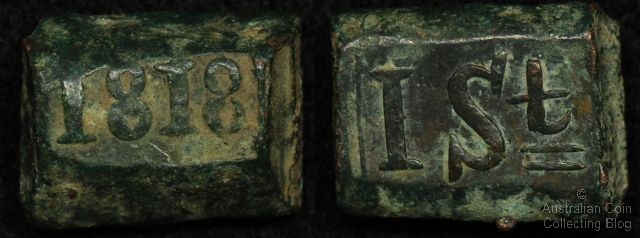
Kingdom of Holland - Netherlands East Indies 1818 1 Stuiver "Bonk" Coinage
A rather interesting type of coinage was issued by the Dutch from their East Indies colony in the late 18th and early 19th centuries was the so called 'bonk' coinage. Cut from oval or rectangular copper bars known as 'bonks' (meaning 'large piece' in Dutch) the irregular lozenge shaped bonk coinage was usually stamped with a year and denomination. It was an emergency or stopgap issue designed to quickly and cheaply supply coinage to a colony that was rich with trade yet short on coinage. The reasons for the shortage of coinage in the East Indies were strongly linked to the political upheavals in the parent Netherlands from 1795 through to 1815. Political turmoil in the Netherlands during the period of mintage of Bonks included the end of the Dutch Republic in 1795, the formation and collapse of the French Batavian Republic from 1795 to 1806, and the founding of the French puppet Kingdom of Holland from 1806-1813. This Kingdom ended with the defeat of Napolean at Leipzig in 1813 and was succeeded by the independent Kingdom of the Netherlands in 1815 which only ceased to exist in 1949.
During the period of the puppet Kingdom of Holland the Netherlands actually lost control of the East Indies Colonies completely to the British (in 1810), but Dutch rule was re-established in 1814. One can imagine that during this 20 years of chaos that the supply of coinage to a colony several thousand miles away would have been far from the minds of government officials. Thus the East Indies had to rely on countertamped coinage of other countries and colonies as well as locally minted currency.
The bonk coinage was made in preference to milled round coinage in times of immediate need because they were much cheaper and easier to make. Manufactured in Batavia (Java), they were cut from copper rods which varied greatly in size and were generally imported from Japan. Denominations issued included the 1/2 Stuiver, 1 Stuiver, 2 Stuiver, and 8 Stuivers. The weights of the coins varied considerably as quality control was poor and the stuiver was continually being de-valued, however the bonks made in the late 18th century massed about 20g of copper for a single stuiver and 45g for a 2 stuiver. Those bonks made later were lighter, down to 19g for a stuiver in 1805 and to 15g for one minted in 1818-9. This effectively devalued the stuiver against the Dutch Guilder (the normal rate was 20 stuivers to the guilder and ended up being 24 stuivers to the guilder in later years).
Copper bonk coins were minted in 3 distinct periods, 1796 to 1806 (under the Batavian Republic), 1807 to 1810 (under the Kingdom of Holland), and 1818-1819 (under the Kingdom of Netherlands). Many varieties existed but generally those minted prior to 1818 displayed the value in a pearled or dotted border on one side and the date in a similar border on the other. Those minted in 1818-1819 displayed the value on one side without a border and the date on the other in a lined rectangle. The coins minted earlier can be quite rare and valuable while the later dates are a little more common. Collectors should be aware that being pure copper these coins can attain a green patina (as distinct to harmful verdigris).
References:
Bruce II, Colin R. and Michael, Thomas (2006) Standard Catalog of World Coins (1801-1900). Iola Wisconsin, USA : Krause Publications
Bucknill, John (2000) The Coins of The East Indies : and introduction to the study of the series. New Dehli, India : Asian Educational Services.
Netherlands Indies Gulden In Wikipedia, The Free Encyclopedia. Retrieved February 24, 2011, from http://en.wikipedia.org/wiki/Netherlands_Indies_gulden
The Netherlands In Wikipedia, The Free Encyclopedia. Retrieved February 24, 2011, from http://en.wikipedia.org/wiki/Netherlands
Posted by mnemtsas at February 24, 2011 7:53 AM
Subscribe to our Newsletter


